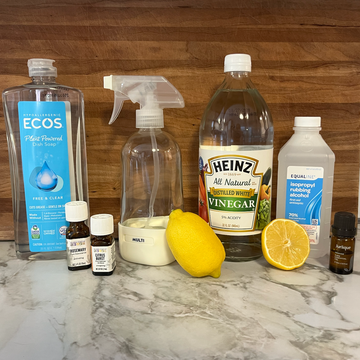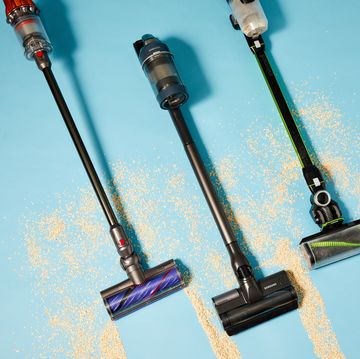Hand-washing is for more than just delicate fabrics — it's a gentle alternative to machine-washing and a great way to clean a couple of things when you don't have a full load to run. Not sure how to get started? We're sharing step-by-step directions for hand-washing everything from sweaters to bras and underwear.
Washing clothes by hand allows for an extreme level of care from start to finish. Before you begin, check your garment's care instructions to see what temperature and laundry products are safe to use — otherwise you run the risk of shrinking, stretching and discoloration. If a garment says "dry clean only," don't wash it by hand. If it just reads "dry clean," there's a chance it can be hand-washed, but to be safe, do this first: drop a bit of water on a hidden spot and blot it to see whether color transfers or a water spot forms. If it doesn't, hand-washing is an option, just stick with cold water and a mild detergent.
For foolproof instructions for how to hand-wash clothes in your sink at home, we tapped Carolyn Forté, the executive director of the Good Housekeeping Institute Cleaning Lab.
How to Hand-Wash Clothes
This step-by-step guide will work for most garments, including dresses, although they can be more cumbersome to handle. Save time by washing like items together, whether they share the same color or fabric type.
- Check the care label and select a laundry detergent. A typical liquid or powder detergent should work, but keep in mind that more delicate fabrics may require a more gentle detergent — think free and gentle detergent, fine fabric detergent or mild dish liquid.
- Pre-treat stains. Work laundry stain remover or liquid detergent into the stain with your fingertips, avoiding vigorous scrubbing to prevent the stain from spreading or setting in deeper. Rubbing the strain too hard can also abrade and damage the fabric.
- Fill the sink with water. Use lukewarm or warm water depending on your garment's care label, but note that wool, silk and bright colors clean best in cold water. While the water is running, add the recommended dose of detergent and swish around to dissolve.
- Soak the garment. Place it in the sink and gently press down to fully submerge. While it soaks, squeeze the sudsy water through the garment several times. If the water changes color, don't worry — it's most likely the result of excess dye and shouldn't affect the garment's color.
- Optional: Pay extra care to dresses. Make sure to support the bottom of long items, especially knit dresses, when wet to keep them from stretching.
- Rinse thoroughly. If you have a sprayer on your faucet, place lightweight garments like sheer tights and swimsuits in a colander and rinse clean. Otherwise, fill the sink with cool water, immerse the garment and squeeze the water through to rinse. Repeat as needed.
- Remove excess water. Wringing out wet, delicate fabrics can cause damage, so carefully lift the garment and gently squeeze out as much water as possible. Lay it flat on a towel and roll the towel and garment together until the water is absorbed.
- Lay it flat to dry. Reshape the damp garment, especially knits, to its desired shape and lay it flat to dry. Once the front is dry, flip it over.
How to Hand-Wash Bras and Underwear
Hand-washing your bra is the best way to ensure that it maintains its shape and fit. It's also the safest method for washing some underwear styles — like those made of lace or silk. Follow the steps below for a gentle yet thorough way to clean undergarments.
- Fill the sink with water. Unless the undergarment's care tag specifies a different temperature, use lukewarm water for bras and warm water for underwear. As the water is running, add a gentle detergent and make sure it dissolves completely before adding the undergarments.
- Let the undergarments soak. Carefully place bras or underwear in the water, gently pressing them down to submerge and swishing the detergent in the water to work it into the undergarments. Let bras soak for 15 minutes and underwear for up to 30 minutes. You can wash multiple pieces simultaneously if they're the same color and fiber type.
- Rinse thoroughly. If you have a sprayer on your faucet, place the bras or underwear in a colander and rinse them clean. Otherwise, fill the sink with cool water, immerse the undergarments and gently squeeze the water through to rinse.
- Gently squeeze, reshape and dry flat. Remove excess water by gently squeezing the bra's straps, back and cups or pat them dry with a towel. Similarly, gently squeeze excess water out of underwear then blot with a towel. Once you've removed as much water as possible, reshape the undergarments and lay them flat to air dry.
How to Hand-Wash Sweaters
There's a common misconception that sweaters must be dry cleaned. However, that's not always the case. Check the care tag first, but if it only says "dry clean," it may be safe to hand-wash. If it's marked as "dry clean only," err on the safe side and drop it off at the dry cleaner.
- Check the sweater's care tag. Review the sweater's care and fiber tags to determine the recommended water temperature. For most sweaters, lukewarm water and a gentle detergent or mild dish liquid should work.
- Pre-treat stains. Use a laundry stain remover or liquid detergent to pre-treat stains. Gently work the product into the stain with your fingertips but don't scrub the area to prevent the stain from spreading or the fabric from damaging.
- Fill your sink with water. As the water is running, add detergent and make sure it dissolves completely before placing a sweater that has been flipped inside-out in the sink. Let it soak for at least 10 minutes; every few minutes, you can squeeze and work the sudsy water through the fabric as it soaks.
- Rinse thoroughly. Fill the sink with cool water, immerse the sweater and squeeze the water through to rinse.
- Remove excess water. Gently squeeze the sweater to remove as much water as possible, then lay it flat on an absorbent towel and gently roll the towel and garment together until the water is absorbed.
- Air dry the sweater. Lay the sweater on top of a dry towel and let it air dry. Once the front is dry, flip it over.

Amanda Garrity is a lifestyle writer and editor with over seven years of experience, including five years on staff at Good Housekeeping, where she covered all things home and holiday, including the latest interior design trends, inspiring DIY ideas and gift guides for any (and every) occasion. She also has a soft spot for feel-good TV, so you can catch her writing about popular shows like Virgin River, Sweet Magnolias, Hallmark Channel’s When Calls the Heart and more.
Maria Sabella is a lifestyle writer with a passion for home and interiors — from paint colors and holiday decor to the latest design trends. Her work has appeared in outlets including Better Homes & Gardens, The Spruce, BuzzFeed and Bustle.















